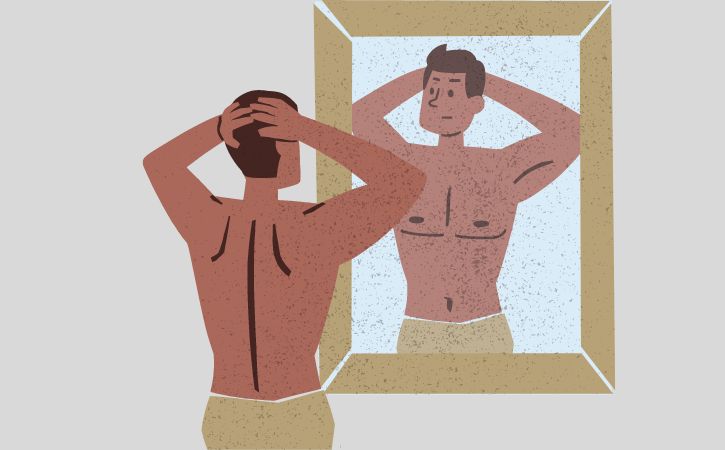Gynecomastia, often colloquially referred to as “man boobs,” is a condition characterised by the enlargement of breast tissue in males. While it’s not uncommon and affects a significant portion of the male population at some point in their lives, it can still be a source of embarrassment and psychological distress for many individuals.
Understanding Gynecomastia
Causes
Gynecomastia can arise from a variety of factors, but hormonal imbalances are often at the core. During puberty, hormonal fluctuations can lead to temporary breast tissue enlargement in boys. This typically resolves on its own as hormone levels stabilise. In older men, declining testosterone levels relative to oestrogen can also contribute to gynecomastia.
Apart from hormonal changes, certain medications can induce gynecomastia as a side effect. These may include some types of antidepressants, antipsychotics, and medications used for prostate conditions or heartburn. Illicit substances like anabolic steroids or marijuana can also play a role in breast tissue enlargement.
Genetics can predispose individuals to gynecomastia, with some families showing a higher incidence of the condition. Lifestyle factors such as obesity can exacerbate gynecomastia since excess fat can mimic breast tissue, making the condition more pronounced.
Symptoms of Gynecomastia
The primary symptom of gynecomastia is the presence of firm or rubbery tissue beneath the nipples. This tissue is typically symmetrical and can be tender or sensitive to touch. In some cases, gynecomastia may cause nipple discharge, but this is less common.
Diagnosis of Gynecomastia
Diagnosing gynecomastia involves a physical examination by a healthcare provider. They will assess the size and firmness of the breast tissue and inquire about medical history, including any medications or supplements being taken. Sometimes, blood tests may be ordered to evaluate hormone levels and rule out underlying conditions like thyroid disorders.
Imaging studies such as ultrasound or mammography may be recommended in certain cases to differentiate between gynecomastia and other breast abnormalities like tumours.
Management and TreatmentObservation
In many instances, especially during puberty, gynecomastia resolves on its own without the need for medical intervention. It’s often recommended to observe the condition for up to two years before considering treatment, as hormonal fluctuations may naturally correct the enlargement.
Lifestyle Modifications
For individuals with gynecomastia related to obesity, lifestyle changes such as healthy eating and regular exercise can be beneficial. Losing excess weight can reduce fat deposition in the breast area, thus improving the appearance of gynecomastia.
Medications
In cases where gynecomastia persists or is causing significant discomfort, medication may be prescribed. Selective oestrogen receptor modulators (SERMs) such as tamoxifen or raloxifene can help by blocking oestrogen receptors in breast tissue, reducing the size of the breasts. However, these medications are not without potential side effects and must be used under medical supervision.
Aromatase inhibitors, which inhibit the conversion of testosterone to oestrogen, are another option for treating gynecomastia, especially in men with hormonal imbalances.
Surgery
When conservative measures fail to address gynecomastia satisfactorily, surgical intervention may be considered. The most common procedure for gynecomastia is mastectomy or breast reduction surgery. During this procedure, excess breast tissue and fat are surgically removed, resulting in a flatter chest contour.
Surgery is typically recommended for individuals with persistent gynecomastia, significant breast enlargement, or psychological distress related to the condition. It’s essential to consult with a board-certified plastic surgeon experienced in gynecomastia surgery to discuss the risks, benefits, and expected outcomes.
Psychological Impact and Support
While gynecomastia is primarily a physical condition, its psychological impact should not be underestimated. Many individuals with gynecomastia experience feelings of embarrassment, self-consciousness, and anxiety about their appearance. This can lead to avoidance of activities like swimming or changing clothes in public, affecting quality of life and self-esteem.
It’s crucial for individuals with gynecomastia to seek support from healthcare providers who understand the emotional aspects of the condition. Counselling or therapy can be beneficial in addressing body image issues and building self-confidence. Support groups or online communities for gynecomastia can also provide a sense of camaraderie and shared experiences.
Conclusion
Gynecomastia is a common condition characterised by the enlargement of breast tissue in males. While it may resolve on its own in many cases, persistent or severe gynecomastia may require medical intervention. Treatment options range from observation and lifestyle modifications to medications and surgery, depending on the underlying cause and individual needs. Beyond the physical aspect, addressing the psychological impact of gynecomastia is crucial for overall well-being. Seeking support from healthcare professionals, counsellors, or support groups can help individuals navigate the emotional challenges associated with gynecomastia and improve their quality of life.


